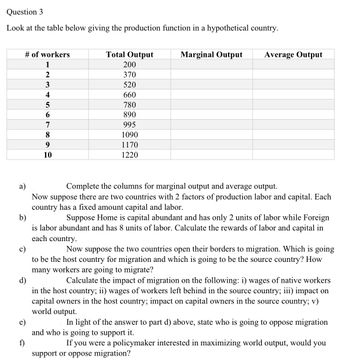
ENGR.ECONOMIC ANALYSIS
14th Edition
ISBN: 9780190931919
Author: NEWNAN
Publisher: Oxford University Press
expand_more
expand_more
format_list_bulleted
Question
Please help me with this question in detail. Thank you

Transcribed Image Text:Question 3
Look at the table below giving the production function in a hypothetical country.
# of workers
1
Total Output
200
2
370
3
520
4
660
5
780
6
890
7
995
8
1090
9
1170
10
1220
Marginal Output
Average Output
a)
b)
c)
d)
f)
Complete the columns for marginal output and average output.
Now suppose there are two countries with 2 factors of production labor and capital. Each
country has a fixed amount capital and labor.
Suppose Home is capital abundant and has only 2 units of labor while Foreign
is labor abundant and has 8 units of labor. Calculate the rewards of labor and capital in
each country.
Now suppose the two countries open their borders to migration. Which is going
to be the host country for migration and which is going to be the source country? How
many workers are going to migrate?
Calculate the impact of migration on the following: i) wages of native workers
in the host country; ii) wages of workers left behind in the source country; iii) impact on
capital owners in the host country; impact on capital owners in the source country; v)
world output.
In light of the answer to part d) above, state who is going to oppose migration
and who is going to support it.
If you were a policymaker interested in maximizing world output, would you
support or oppose migration?
Expert Solution
This question has been solved!
Explore an expertly crafted, step-by-step solution for a thorough understanding of key concepts.
Step by stepSolved in 2 steps

Knowledge Booster
Similar questions
- I really need some help on the below. I am not sure what topics i should be covering in each answer. The Federal Department of Industry and Science has cut its price forecast for iron ore in 2015 by 10 per cent to $US54.40 a tonne, citing a weak outlook for China's steel sector. The commodity - which climbed as high as $US65.61 a tonne on June 11, the peak in its recent rebound from April lows - was bringing $US61.29 on Monday night and many analysts predicted further falls. The department's forecast for 2016 was $US52.10 a tonne. "China's steel production is forecast to contract in 2015 and 2016 as the seaborne supply of iron ore increases," the department said in its latest quarterly update. Iron ore is a key ingredient of steel. Question 1 - Using demand and supply analysis, explain the impact of the change in commodity price on the market for iron ore mine workers.arrow_forwardplease do d and e now pleasearrow_forwardPlz write detailed information as much as you can Plz be specificarrow_forward
- High quality information gruarantees that every decisions made will be a successful one that benefits the organizationarrow_forwardAre you able to assist me with the last two questions?arrow_forwardPlease pass question on to someone with more knowledge. I do not like using up my questions for wrong answers.arrow_forward
- When does the money have time value?arrow_forwardExplain persuasive writing in your own words? Perhaps recall an online purchase where you were upsold based on description etc. or bought something you later regretted as an example.arrow_forwardName the three general categories of Resourcesarrow_forward
arrow_back_ios
arrow_forward_ios
Recommended textbooks for you

 Principles of Economics (12th Edition)EconomicsISBN:9780134078779Author:Karl E. Case, Ray C. Fair, Sharon E. OsterPublisher:PEARSON
Principles of Economics (12th Edition)EconomicsISBN:9780134078779Author:Karl E. Case, Ray C. Fair, Sharon E. OsterPublisher:PEARSON Engineering Economy (17th Edition)EconomicsISBN:9780134870069Author:William G. Sullivan, Elin M. Wicks, C. Patrick KoellingPublisher:PEARSON
Engineering Economy (17th Edition)EconomicsISBN:9780134870069Author:William G. Sullivan, Elin M. Wicks, C. Patrick KoellingPublisher:PEARSON Principles of Economics (MindTap Course List)EconomicsISBN:9781305585126Author:N. Gregory MankiwPublisher:Cengage Learning
Principles of Economics (MindTap Course List)EconomicsISBN:9781305585126Author:N. Gregory MankiwPublisher:Cengage Learning Managerial Economics: A Problem Solving ApproachEconomicsISBN:9781337106665Author:Luke M. Froeb, Brian T. McCann, Michael R. Ward, Mike ShorPublisher:Cengage Learning
Managerial Economics: A Problem Solving ApproachEconomicsISBN:9781337106665Author:Luke M. Froeb, Brian T. McCann, Michael R. Ward, Mike ShorPublisher:Cengage Learning Managerial Economics & Business Strategy (Mcgraw-...EconomicsISBN:9781259290619Author:Michael Baye, Jeff PrincePublisher:McGraw-Hill Education
Managerial Economics & Business Strategy (Mcgraw-...EconomicsISBN:9781259290619Author:Michael Baye, Jeff PrincePublisher:McGraw-Hill Education


Principles of Economics (12th Edition)
Economics
ISBN:9780134078779
Author:Karl E. Case, Ray C. Fair, Sharon E. Oster
Publisher:PEARSON

Engineering Economy (17th Edition)
Economics
ISBN:9780134870069
Author:William G. Sullivan, Elin M. Wicks, C. Patrick Koelling
Publisher:PEARSON

Principles of Economics (MindTap Course List)
Economics
ISBN:9781305585126
Author:N. Gregory Mankiw
Publisher:Cengage Learning

Managerial Economics: A Problem Solving Approach
Economics
ISBN:9781337106665
Author:Luke M. Froeb, Brian T. McCann, Michael R. Ward, Mike Shor
Publisher:Cengage Learning

Managerial Economics & Business Strategy (Mcgraw-...
Economics
ISBN:9781259290619
Author:Michael Baye, Jeff Prince
Publisher:McGraw-Hill Education